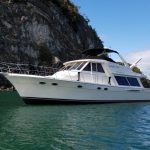Cummins Marine Diesel Repower Specialists › Forums › Cummins Marine Engines › Fresh water flush, 6bta
- This topic has 23 replies, 11 voices, and was last updated 4 years ago by
 Rob Schepis.
Rob Schepis.
-
CreatorTopic
-
September 10, 2018 at 10:14 am #36972
Any reason why I couldn’t install a fresh water flush input at the bung on the SMX water pump. I seems to me that this would allow the fresh water (engine is off) to circulate past the impeller, through the entire system, and then down the exhaust. I do have the right elevations so that the exit water wouldn’t back up the wrong direction…
-
CreatorTopic
-
AuthorReplies
-
July 23, 2019 at 3:11 pm #75755

Rob SchepisForum ModeratorVessel Name: Tenacious
Engines: 6BTA 5.9 330's - "Seaboard Style"
Location: Long Island, NY
Country: USA
Would not just closing off the raw water sea cock opening up the strainer and putting a fresh water hose from the dock and running the engine for 5 or 10 minutes do it?
Frank that certainly does work if you have good strainer access with a garden hose.
1 user thanked author for this post.
July 23, 2019 at 12:47 pm #75741Fresh watyer flush
2″ bronze elbow at seacock. Drilled hole in elbow, tig welded 1/2″ pipe nipple. There is an adapter available at any hardware store for a hose fitting to 1/2″ female pipe. Shut off through hull, remove cap, hook up hose adapter, turn on hose and start. Don’t forget to open seacock when done.
July 21, 2019 at 1:17 pm #75611Is it a "must do" to have a plumbed in fresh water flush connection?
Would not just closing off the raw water sea cock opening up the strainer and putting a fresh water hose from the dock and running the engine for 5 or 10 minutes do it?
September 15, 2018 at 4:35 pm #37184
RussParticipantVessel Name: Intangible Asset
Engines: 6BTA 5.9-M3 330's
Location: Anacortes, WA
Country: USA
I have installed a fresh water flush on my 6BTA 330’s. I ran hose with quick disconnects and shut offs from the port aft laz corner secured along the bottom of the cockpit sole to the geny sea strainer and then on to each engine sea strainer with shut off valves tapped into the top of each sea strainer. When I get back to the dock I connect dock water (which has great flow/pressure), open the inlet value and outlet valve on either side of the quick disconnect. Then, one at a time, with the sea cock still open, I open the inlet to the sea strainer and let if flush the salt water as much as it can while I start the engine and let it run for 5 minutes. Shut down, shut the inlet valve, repeat for next engine and then a geny but a little less time. I have pulled the bottom aftercooler zinc and while the water is not “fresh” it is only slightly salty and the zincs are lasting much longer (as well as other internal parts I imagine) from not sitting in salt water all week or longer between uses. It also has the added bonus of making sure after each outing I spend 5 minutes crawling around and examining each engine while it runs during the flushing. Already found/fixed things I would have missed for some time otherwise I expect…
September 14, 2018 at 9:52 pm #37167QSB 5.9L flush?
If it were me, I’d plumb in a standard garden hose to the strainer, leave the seacock OPEN, let the hose run flat (still 100% okay) and taste the water towards the end of run to see how you did… I bet you you’ll be surprised and happy.
Cory, today I tried a fresh water flush for the first time. I have a strainer cap with a garden hose attachment to the cap. What I had hoped to be able to do was just what you suggest, leave the seacock open and run the hose while running the engine. I was concerned however about the flow from the hose being adequate.
What I did was fill a 5 gallon bucket with a hose and connect a short hose from the strainer cap and the end in the bucket. I closed the seacock and ran the engine. It emptied the bucket in less than a minute. I shut the engine down and refilled the bucket but left the hose running into the bucket when I started the engine. This time the bucket emptied about half as fast.
What this little experiment told me was that the hose on the dock only provided about 1/2 the flow the engine wanted.
So, my assumption is that in my situation your proposed plan won’t work. Is that correct? The other question is, how much water does it take to flush the engine? Assuming I started with a full 5 gallon bucket and kept the hose running, I am guessing that I could get about 10 gallons into the engine. Is that enough to flush it adequately?
September 13, 2018 at 6:39 am #37108
Bill DesmaraisModeratorVessel Name: Extremist
Engines: Cummins 6BTA 370
Location: Portsmouth, NH
Country: United States
Mike,
I’ve owned five 6BTA 370s. Three new ReCons and an old pr. of badly used 370s.
I service the after cooler every three seasons. Coolers are serviced per Tony’s specs with gobs of MetalLube grease. The boat is in a 40/60 fresh/saltwater river mix with the tide changes.
I have not converted to a fresh water flush the yet but plan to for next season.
I have noticed minor “pitting” on the bottom base ring of the after cooler core even with a three season service interval using grease. Dissimilar metals.
Boating season up here in the Northeast is May 15th thru Oct 15th.
September 12, 2018 at 5:15 pm #37096
Corey SchmidtForum ModeratorVessel Name: Rebel Belle
Engines: Cummins
Location: Oxnard, CA
Country: USA
If it were me, I’d plumb in a standard garden hose to the strainer, leave the seacock OPEN, let the hose run flat (still 100% okay) and taste the water towards the end of run to see how you did… I bet you you’ll be surprised and happy.
September 12, 2018 at 3:19 pm #37095
Brian KatzParticipantWhat size diverter valve should be used? I think the line is 1.75″, but would a 1.5″ valve (with 1.75″ hose fittings) suffice?
I wouldn’t think you would need a giant diverter valve. If it were mine I would put a 1.5″ ball valve to close off flow to the elbow and use the bung on the HE to install a barbed fitting and run a small hose off that with an appropriate ball valve of its own. You don’t need a giant hose to flush the system. Close one and open the other. You would lose a pencil zinc as a trade off.
Again just throwing ideas around I have no actual experience with this setup.
September 12, 2018 at 12:58 pm #37092What size diverter valve should be used? I think the line is 1.75″, but would a 1.5″ valve (with 1.75″ hose fittings) suffice?
September 12, 2018 at 12:08 pm #37089Looks like lift mufflers, if so the engine must be running regardless of exhaust geometry (even if engine dry riser is the highest point in the system) or you need to crack open a drain on the muffler which is likely not realistic. I would set it up with the dockside water and let the engine run and flatten the hose, won’t hurt anything at idle since the impeller stays wet. Then pop a zinc and taste what you have sitting in your aftercooler and/or heat-ex and go from there as to seacock open, closed, etc..
Thanks for the info about the lift muffler – I didn’t know that (bullet dodged)! Looks like I need to decide about using dockside water with the engine running, or to install a diverter valve before the mixer (too heavy for the hose?).
September 12, 2018 at 12:06 pm #37088I’m new to the 6B but… If you plumbed in a diverter valve between the HE and exhaust elbow couldn’t you dump the water overboard( or a destination of your choice) via an additional thru hull?
This would also eliminate condensation inside the elbow from running cold water through the elbow.
This of course would be a non-running application. You wouldn’t want to run a dry elbow for long if at all.
There’s no free lunch as you would have to be very careful to reset back to “running mode” when you finished your flush but you probably be done in an efficient manner.
Just a thought. Seems good in writing.
This sounds like a good idea. But a 1.5″ bronze diverter valve weighs about 6lbs… is this to much weight to hang in the middle of the water outlet hose? I don’t see that there would be a place to secure a valve to something rigid.
September 12, 2018 at 10:17 am #37085
Brian KatzParticipantI’m new to the 6B but… If you plumbed in a diverter valve between the HE and exhaust elbow couldn’t you dump the water overboard( or a destination of your choice) via an additional thru hull?
This would also eliminate condensation inside the elbow from running cold water through the elbow.
This of course would be a non-running application. You wouldn’t want to run a dry elbow for long if at all.
There’s no free lunch as you would have to be very careful to reset back to “running mode” when you finished your flush but you probably be done in an efficient manner.
Just a thought. Seems good in writing.
September 12, 2018 at 10:04 am #37084
Rob SchepisForum ModeratorVessel Name: Tenacious
Engines: 6BTA 5.9 330's - "Seaboard Style"
Location: Long Island, NY
Country: USA
Looks like lift mufflers, if so the engine must be running regardless of exhaust geometry (even if engine dry riser is the highest point in the system) or you need to crack open a drain on the muffler which is likely not realistic. I would set it up with the dockside water and let the engine run and flatten the hose, won’t hurt anything at idle since the impeller stays wet. Then pop a zinc and taste what you have sitting in your aftercooler and/or heat-ex and go from there as to seacock open, closed, etc..
September 12, 2018 at 8:22 am #37073I think we need to see some more pictures of the muffler configuration… worst thing that could happen is if the muffler can fill up with water and cause too much back pressure when starting the engine… no bueno.
Are you in 100% salt water at the dock/slip? Have you thought of plumbing a garden hose into the strainer or suction hose and running the engines with the through hulls open as an alternative? Even an 80/20 water mix is 100% better than nothing at all and will extend engine life decades+++
Yes, 100% salt. Interesting idea, but I’m not all that sure I could get an 80/20 mix because the water pressure/volume at the dock isn’t very good. It would probably be more like 40/60 or something. I was also thinking about closing the through hulls and running with just the water hose but I think the suction would just collapse the hose.
I’ll get some more pics of the muffler configuration when I go up to the boat this weekend.
September 12, 2018 at 8:18 am #37071What does it look like from the mixer to the muffler?
This is the hose from the mixer to the muffler. It’s a slight decline all the way down…
September 11, 2018 at 5:27 pm #37055
Corey SchmidtForum ModeratorVessel Name: Rebel Belle
Engines: Cummins
Location: Oxnard, CA
Country: USA
I think we need to see some more pictures of the muffler configuration… worst thing that could happen is if the muffler can fill up with water and cause too much back pressure when starting the engine… no bueno.
Are you in 100% salt water at the dock/slip? Have you thought of plumbing a garden hose into the strainer or suction hose and running the engines with the through hulls open as an alternative? Even an 80/20 water mix is 100% better than nothing at all and will extend engine life decades+++
September 11, 2018 at 4:12 pm #37051What does it look like from the mixer to the muffler?
September 11, 2018 at 2:11 pm #37042What is in-between the mixer and the transom? both sides… If a muffler, what exact style.. Total drop to the muffler and distance? Drop from muffler to exit? Thing of a marble and what it would do!
Plus, if we determine it might be safe, you would pump into the pump AFTER the impeller, not before ( top test port)
Tony
The installation would pass the marble test. As you can see, the big exhaust hose coming out of the elbow angles slightly downward to the muffler in the lazarette. Then, the output exhaust from the muffler to the exit is all well under the level of the mixer (elbow). So, unless I’m mistaken the marble would never run the other way. But… at the mixer, do you think I’m safe? The input is definitely over the hump in the “exit” direction, but it is pretty dang close to the top of the hump. Here are a couple more pics downstream of the mixer…
September 11, 2018 at 2:00 pm #37040
Tony AthensModeratorVessel Name: Local Banks
Engines: QSB 6.7 550 HP
Location: Oxnard, CA
Country: USA
What is in-between the mixer and the transom? both sides… If a muffler, what exact style.. Total drop to the muffler and distance? Drop from muffler to exit? Thing of a marble and what it would do!
Plus, if we determine it might be safe, you would pump into the pump AFTER the impeller, not before ( top test port)
Tony
September 11, 2018 at 12:53 pm #37037Not all that steep of a downward pitch running aft there, don’t park her downhill before you flush!
Is it enough of a pitch or would this be too much of a risk? I’d really like to flush with fresh water but I’m worried about potential for catastrophic consequences!
-
AuthorReplies
You must be logged in to reply to this topic.
